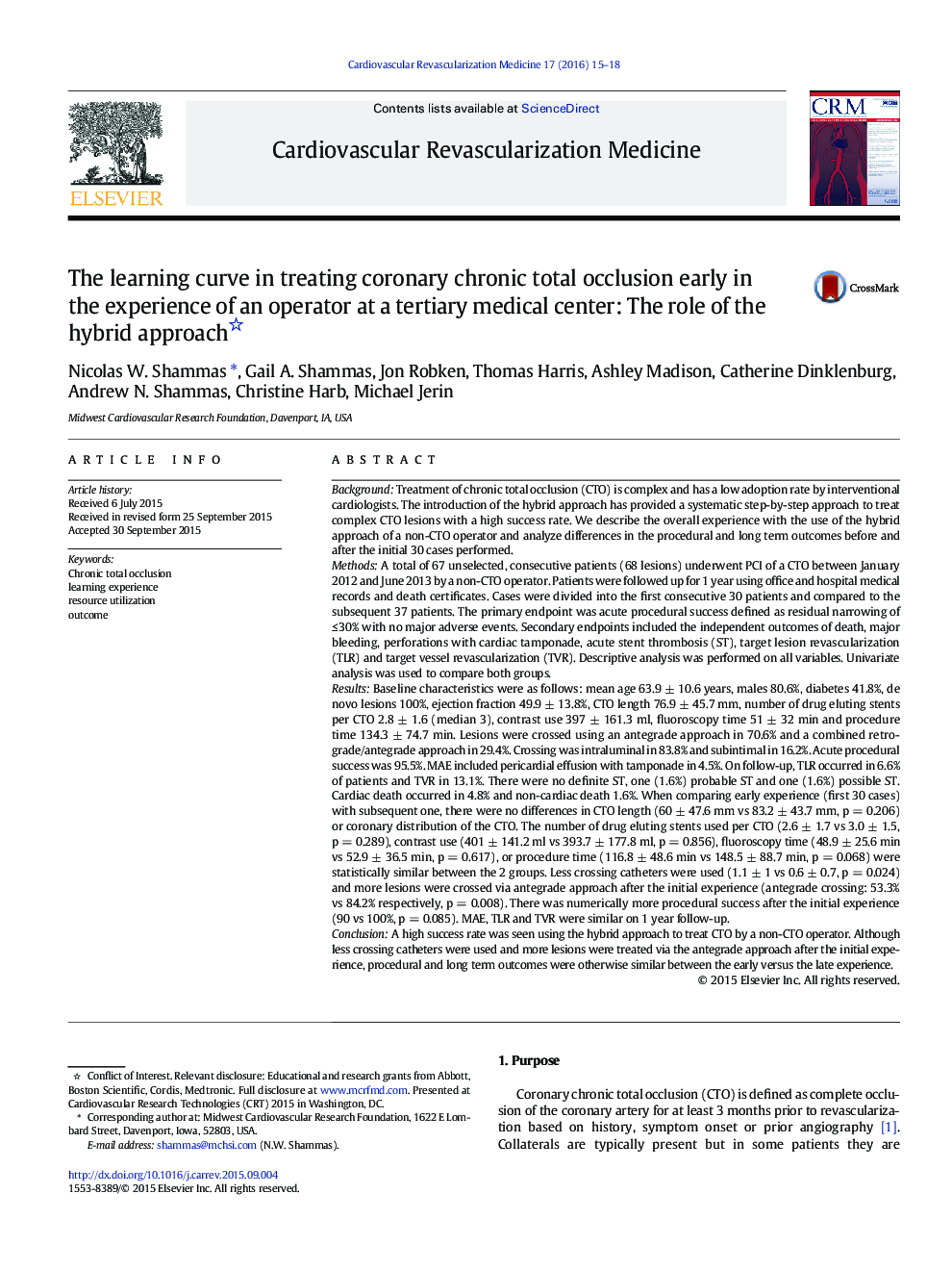| کد مقاله | کد نشریه | سال انتشار | مقاله انگلیسی | نسخه تمام متن |
|---|---|---|---|---|
| 2836884 | 1164864 | 2016 | 4 صفحه PDF | دانلود رایگان |
BackgroundTreatment of chronic total occlusion (CTO) is complex and has a low adoption rate by interventional cardiologists. The introduction of the hybrid approach has provided a systematic step-by-step approach to treat complex CTO lesions with a high success rate. We describe the overall experience with the use of the hybrid approach of a non-CTO operator and analyze differences in the procedural and long term outcomes before and after the initial 30 cases performed.MethodsA total of 67 unselected, consecutive patients (68 lesions) underwent PCI of a CTO between January 2012 and June 2013 by a non-CTO operator. Patients were followed up for 1 year using office and hospital medical records and death certificates. Cases were divided into the first consecutive 30 patients and compared to the subsequent 37 patients. The primary endpoint was acute procedural success defined as residual narrowing of ≤ 30% with no major adverse events. Secondary endpoints included the independent outcomes of death, major bleeding, perforations with cardiac tamponade, acute stent thrombosis (ST), target lesion revascularization (TLR) and target vessel revascularization (TVR). Descriptive analysis was performed on all variables. Univariate analysis was used to compare both groups.ResultsBaseline characteristics were as follows: mean age 63.9 ± 10.6 years, males 80.6%, diabetes 41.8%, de novo lesions 100%, ejection fraction 49.9 ± 13.8%, CTO length 76.9 ± 45.7 mm, number of drug eluting stents per CTO 2.8 ± 1.6 (median 3), contrast use 397 ± 161.3 ml, fluoroscopy time 51 ± 32 min and procedure time 134.3 ± 74.7 min. Lesions were crossed using an antegrade approach in 70.6% and a combined retrograde/antegrade approach in 29.4%. Crossing was intraluminal in 83.8% and subintimal in 16.2%. Acute procedural success was 95.5%. MAE included pericardial effusion with tamponade in 4.5%. On follow-up, TLR occurred in 6.6% of patients and TVR in 13.1%. There were no definite ST, one (1.6%) probable ST and one (1.6%) possible ST. Cardiac death occurred in 4.8% and non-cardiac death 1.6%. When comparing early experience (first 30 cases) with subsequent one, there were no differences in CTO length (60 ± 47.6 mm vs 83.2 ± 43.7 mm, p = 0.206) or coronary distribution of the CTO. The number of drug eluting stents used per CTO (2.6 ± 1.7 vs 3.0 ± 1.5, p = 0.289), contrast use (401 ± 141.2 ml vs 393.7 ± 177.8 ml, p = 0.856), fluoroscopy time (48.9 ± 25.6 min vs 52.9 ± 36.5 min, p = 0.617), or procedure time (116.8 ± 48.6 min vs 148.5 ± 88.7 min, p = 0.068) were statistically similar between the 2 groups. Less crossing catheters were used (1.1 ± 1 vs 0.6 ± 0.7, p = 0.024) and more lesions were crossed via antegrade approach after the initial experience (antegrade crossing: 53.3% vs 84.2% respectively, p = 0.008). There was numerically more procedural success after the initial experience (90 vs 100%, p = 0.085). MAE, TLR and TVR were similar on 1 year follow-up.ConclusionA high success rate was seen using the hybrid approach to treat CTO by a non-CTO operator. Although less crossing catheters were used and more lesions were treated via the antegrade approach after the initial experience, procedural and long term outcomes were otherwise similar between the early versus the late experience.
Journal: Cardiovascular Revascularization Medicine - Volume 17, Issue 1, January–February 2016, Pages 15–18
